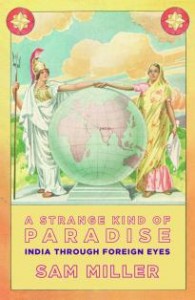India is a mystery – even to people who are born and brought up here. So the foreigners who come here are totally lost and try to make sense of it in many different ways. One of the favorites with current day explorers is to walk in the footsteps of ancient travelers and verify what they said. Look for the remaining traces of their times and document the changes. In between, they also get new experiences or discover some related and unrelated information. The subtitle of this book A Strange kind of Paradise says ‘India Through Foreign Eyes’ and I would add ‘through the ages’ to that.
Sam Miller starts from the first documented traveler to India – Megasthenes. And goes down to current day travelers he is tracing. What they saw, what they said and what still remains of that. He is also celebrating his spending 25 years in India. He is married to an Indian and has explored this country first hand for many years now. That gives him a lot of grip on the subject. The book A Strange kind of Paradise is divided into two segments – one where he traces the journeys of erstwhile travelers. And one where he traces his own rendezvous with India over the years.
What you appreciate about this account is that author traveled to a lot of not so well known places like Patna, Nalanda, Heliodorus pillar in Sanchi, old churches in Kerala and read the literature on them before he writes his account. It is not merely a second-hand research that he engages in. The book is chronological – with oldest travelers first. Now as the time passed the number of travelers increased. But the documentation and the records they left increased manifold. The old travelers are well-known names – be it Megasthenes, Ibn Battuta, Xuanzang or Marco Polo. And we have studied about them sometime somewhere. We know a bit and the author adds to that. The relatively new ones who came after the European dominance are far too many. And they wrote a lot, sometimes by actually traveling around sometimes by just imagining things based on what they heard.
Now, this is where as a reader I lost interest, as most of them were nothing more than names to me. I was not really interested in who married whom, where they came from and where they lived. Unless they told me something about the past that I did not know, or gave it another perspective. Author being of British descent, on the other hand, has immense interest in this era, which is understandable. And probably quite relevant for the English/European reader.
I loved his personal journey of being in India, living with an Indian, learning the real taste of Indian dishes, making Indian friends and learning to accept the country as it is. He sums up his book towards the end in following words and I cannot agree more – for India offers you what you come seeking for:
I’ve found it hard not to develop, over the decades, some crassly unscientific stereotypes of foreign visitors to India. There are Brits who want to save the poor or search for the graves of their ancestors; the Americans who search for themselves and for enlightenment; the newbie journalists who search for the exotic stories they think their audience wants to watch, hear and read; the Italians and the French who search for a fantasy land of Maharajas or happy village simplicity, or cheap gemstones; the east Asians and Sri Lankans who search for anything Buddhist; the Australians who want adventure; the Pakistanis who search for ancestral homes and Sufi Succor; the contemporary youngsters who seek work experience or simply the company of their peers; the big talking entrepreneurs who imagine billion-dollar business opportunities; the spiritual seekers who search out and find a guru.
I met Sam Miller a few years ago in Delhi around the time his book on Delhi was published. And he was kind enough to take us on Lal Kot walk that most Delhites do not even know exists. Subsequently, I contributed in a very small way to his Blue Guide to India and also interviewed him on AnuReviews. I will always remember his words ‘You become a Dilliwallah when you start caring for the city’ something that is true for any city. Ask an eternal migrant like me.
Read this book A Strange kind of Paradise.
You may buy this book – A Strange kind of Paradise: India Through Foreign Eyes by Sam Miller at Amazon.









